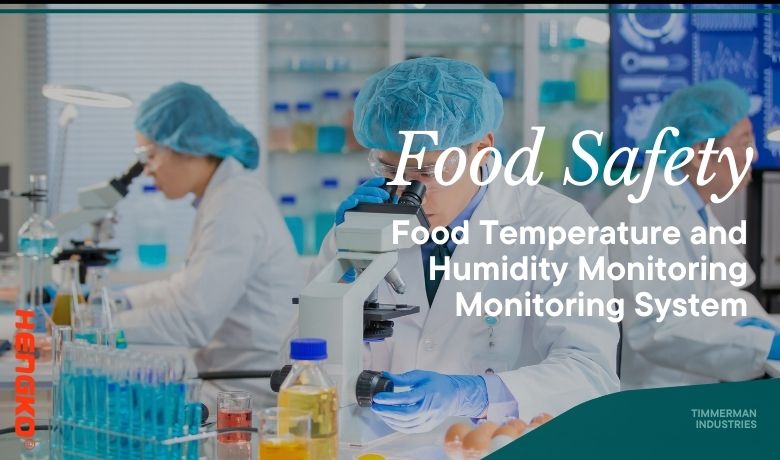Food Temperature and Humidity Monitoring System
The temperature and humidity of food products play a critical role in their quality, safety, and shelf life. Deviations from the recommended temperature and humidity ranges can result in the growth of harmful bacteria, spoilage, and even foodborne illness. To mitigate these risks, food companies are turning to temperature and humidity monitoring systems to ensure that their products remain within the recommended ranges throughout the supply chain.
The Importance of Temperature and Humidity Monitoring in the Food Industry
Food products are highly sensitive to temperature and humidity, and even minor deviations from the recommended ranges can have severe consequences. For example, high temperatures can cause food to spoil or degrade, while low temperatures can result in freezer burn or other types of damage. Similarly, high humidity can cause food to become moldy, while low humidity can cause food to dry out and lose its flavor.
Temperature and humidity monitoring systems allow food companies to track the temperature and humidity of their products throughout the supply chain, from storage to transportation to retail. By using these systems, food companies can ensure that their products remain within the recommended ranges, and ultimately, provide consumers with safe and high-quality food products.
How Temperature and Humidity Monitoring Systems Work
Temperature and humidity monitoring systems use sensors to track the temperature and humidity of food products. These sensors can be integrated into a variety of different types of equipment, including refrigerators, freezers, and transportation containers. The data from these sensors is then transmitted to a central monitoring system, where it can be analyzed and used to make real-time decisions about the management of the food products.
Temperature and humidity monitoring systems can be configured to provide alerts when the temperature or humidity of a food product deviates from the recommended range. This allows food companies to take corrective action quickly, mitigating the risk of product loss and ensuring the safety and quality of the products.
Benefits of Temperature and Humidity Monitoring Systems
Temperature and humidity monitoring systems offer several benefits to food companies, including:
Improved Product Quality
By ensuring that food products remain within the recommended temperature and humidity ranges, temperature and humidity monitoring systems help to maintain their quality and freshness. This can lead to increased customer satisfaction and a better reputation for the food company.
Increased Safety
Temperature and humidity monitoring systems can help to prevent the growth of harmful bacteria and pathogens in food products, reducing the risk of foodborne illness and other health hazards.
Enhanced Efficiency
By providing real-time data on the temperature and humidity of food products, temperature and humidity monitoring systems can help food companies to optimize their supply chain management practices, reducing waste and increasing efficiency.
Applications of Temperature and Humidity Monitoring Systems
Temperature and humidity monitoring systems can be used in a variety of different applications within the food industry. Some common applications include:
1. Refrigeration and Freezing
Temperature and humidity monitoring systems can be used to track the temperature and humidity of refrigerators and freezers, ensuring that the food products stored within them remain within the recommended ranges.
2. Transportation
Temperature and humidity monitoring systems can be used to track the temperature and humidity of food products during transportation, ensuring that they remain within the recommended ranges and are not subjected to extreme temperature or humidity fluctuations.
3. Processing
Temperature and humidity monitoring systems can be used to track the temperature and humidity of food products during processing, ensuring that they are not exposed to conditions that could compromise their safety or quality.
Choosing the Right Temperature and Humidity Monitoring System
When choosing a temperature and humidity monitoring system, it is important to consider factors such as accuracy, reliability, and ease of use. Industrial temperature and humidity sensors are often preferred for food industry applications, as they are designed to withstand harsh environmental conditions and provide accurate and reliable measurements.
It is also important to consider the specific needs of the food company when selecting a temperature and humidity monitoring system. For example, a company that specializes in frozen foods may require a system that is optimized for use in freezers, while a company that specializes in fresh produce may require a system that is optimized for use in refrigerators.
Restaurants, bars, food production and hospitality companies worldwide are responsible for executing an ever-expanding list of refrigeration monitoring requirements from a myriad of governing agencies. Yet many struggle to maintain compliance due to undetected refrigeration failures, resulting in costly consequences.
Food storage temperature monitoring is vital for food freshness. Many facilities manually monitor refrigeration systems, but it’s impossible to manually monitor equipment 24 hours a day. Even periodic monitoring is difficult to sustain. It’s expensive, labor intensive, the readings may not be accurate, and monitoring efforts are of en duplicated in order to meet overlapping regulatory requirements. Operational efficiency suffers as a result, increasing the risk for non-compliance.
HENGKO offers a complete wireless temperature humidity monitoring solution for the food service industry. Whether you are a school district, restaurant, processing plant, or operate any other food related business, we offer a fully automated enterprise-wide solution that makes it easy to monitor your entire food service operation and reduce inventory loss.
In addition to help managers monitor the temperature and humidity of food warehouse in 24h, our food warehouse temperature and humidity online monitoring system also can ensure food safety and cost effective.Digital system management will be the development trend in the future.
Conclusion
Temperature and humidity monitoring systems are an essential tool for ensuring the safety and quality of food products throughout the supply chain. By using these systems, food companies can track the temperature and humidity of their products in real-time, and take corrective action quickly if necessary. This helps to ensure that consumers are provided with safe and high-quality food products.
If you are interested in learning more about temperature and humidity monitoring systems for the food industry, contact us today. Our team of experts can help you choose the right system for your specific needs, and ensure that your food products remain within the recommended temperature and humidity ranges throughout the supply chain.
Invest in the safety and quality of your food products with a temperature and humidity monitoring system.
Contact us today to learn more about our customized solutions for refrigeration, transportation, and processing applications.
Post time: Jul-30-2021







